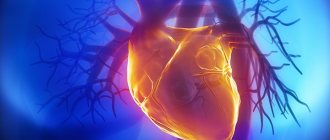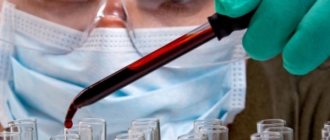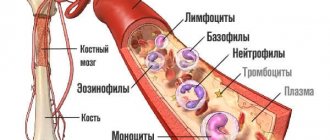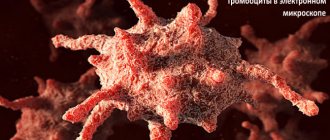Despite the fact that this substance was discovered at the beginning of the last century, to this day the analysis of reactive protein is widely used in any medical practice. If C-reactive protein is elevated, it means there is inflammation in the body, the activity of which helps determine this indicator. And although it is impossible to make any specific diagnosis using this analysis, it can be indispensable when first examining a person or when monitoring the activity of a chronic disease.
You can learn how to interpret the results of the examination, determine the risk of cardiovascular complications and even predict the course of pregnancy using reactive blood protein from this article.
What is SRB
C-reactive protein (abbreviated as CRP) is a complex mixture of carbohydrates and proteins that is produced in liver cells. In the blood of a healthy person, its content is so low that most devices can even show a zero result. The production of this substance is stimulated by any factors that pose a threat to the body. These include:
- Harmful bacteria;
- Any viruses;
- Pathogenic fungi;
- Trauma, including surgery;
- Damage to internal organs (heart attacks, strokes, tissue rupture, etc.);
- Tumors and growth of metastases;
- Autoimmune reactions are immune disorders in which blood cells begin to produce substances that damage healthy tissue.
High C-reactive protein activates the body's defense systems. It is an important part of the immune system, which activates the release of antimicrobial and antiviral substances, and also stimulates the work of protective cells.
A side effect of protein is its effect on fat metabolism. In high concentrations, this compound promotes the deposition of “bad cholesterol” (low-density lipoprotein - LDL) in the artery wall. That is why the measurement of this indicator is used to assess the risk of vascular complications.
Combination of increased CRP with changes in ESR
ESR is a marker of the inflammatory process, determined in a general blood test. It has less sensitivity than CRP. The erythrocyte sedimentation rate depends on gender, age, and time of day. ESR begins to rise within a few days after the disease, increases more slowly, and during treatment decreases longer than CRP. Therefore, C-reactive protein is preferable to use for early diagnosis.
There are only two diseases in which the ESR is significantly higher than normal, but the PRP remains within acceptable values - rheumatoid arthritis and giant cell arteritis. Both diseases are of autoimmune origin. In this case, ESR increases to more than 50 mm/h and serves as a reliable diagnostic criterion. C-reactive protein is an ultrasensitive marker of inflammation. It is actively formed in the liver in response to an infection or autoimmune process in the body. Its growth is determined six hours after the onset of the pathological process. CRP can be used to distinguish between bacterial, viral and autoimmune inflammation and to monitor the effectiveness of treatment.
Norm
Unlike most indicators, the C-reactive protein norm is universal for all groups of the population, regardless of age and gender.
According to the recommendations of WHO doctors, the norm is up to 5 mg/l. In newborns, no more than 15 mg/l.
Exceeding this value, in most cases, allows one to suspect an inflammatory or oncological disease, depending on the presence of certain changes in the person’s body.
With the development of knowledge about this substance and the advent of new high-precision equipment, scientists began to talk about another indicator - it is called the basic value of CRP. This value allows you to assess the risk of damage to the heart and arterial vessels in a person who does not suffer from any inflammatory reaction. The norm for the basic level of reactive protein differs significantly from traditional data - it is less than 1 mg/l.
It is better to take tests in the same laboratory, because CRP is determined by different methods, using:
- ELISA;
- radial immunodiffusion;
- nephelometry,
therefore, repeated results may differ, which will prevent the dynamics from being interpreted correctly.
Comparison with ESR
In addition to C-reactive protein, ESR (erythrocyte sedimentation rate) is also a marker of acute inflammation in the body. What they have in common is that both indicators increase in a number of diseases. What is their difference:
- CRP increases much earlier and decreases faster. Therefore, in the early stages of diagnosis, it is more informative than ESR.
- If the treatment is effective, then the c-reaction. protein decreases on days 7-10, and ESR decreases only after 14-28 days.
- The results of ESR are influenced by the time of day, plasma composition, number of red blood cells, gender (higher in women), but the results of CRP do not depend on these factors.
It becomes clear that the C reactive protein test is a more sensitive method for assessing inflammation than ESR. If you suspect any disease, to establish the cause, determine whether the process is acute or chronic, assess the activity of inflammation and the effectiveness of the therapy, it is more informative and convenient.
Additional reasons for increased CRP in women and children
Increased levels of C-reactive protein in children are most often associated with acute intestinal infections or chronic respiratory diseases. In acute salmonellosis and dysentery, PSA increases to 100-200 mg/l. Against the background of chronic tonsillitis, sinusitis, adenoiditis, PSA increases moderately - 50-80 mg/l.
Another reason for the increase in PSA in children is parasitic infestations. Children often suffer from enterobiasis, ascariasis, and giardiasis. An increase in CRP is combined with an increased level of eosinophils in a general blood test.
According to international recommendations, C-reactive protein in newborns reaches 15 mg/liter. However, if there are signs of intrauterine infection in an infant, active antibacterial therapy is started, even if the CRP is less than 12 mg/l.
In women, a prolonged increase in the indicator can mean chronic gynecological pathology - endometritis, cervicitis, cervical erosion. Also, if CRP is constantly elevated, it is necessary to exclude a common cancer for women - breast cancer.
Reasons for the increase
There are 3 main groups of reasons that can lead to an increase in the content of CRP in the blood - inflammation, oncology and pathology of arterial vessels. They include a huge number of diseases, between which it is necessary to conduct a diagnostic search. The degree of protein increase helps to roughly navigate the pathologies:
- More than 100 mg/l - such a strong immune reaction is most often observed with bacterial infections (microbial pneumonia, salmonellosis, shigellosis, pyelonephritis, etc.);
- 20-50 mg/l – this level is more typical for human viral diseases, such as mononucleosis, adenovirus or rotavirus infection, herpes and others;
- Less than 19 mg/l - a slight excess of the normal value can occur due to any significant factor affecting the body. However, with constantly elevated CRP, autoimmune and oncological pathologies should be excluded.
But the level of CRP is a very approximate indicator, and even the boundaries indicated above are quite arbitrary. It happens that a patient with rheumatoid arthritis has a CRP above 100 during an exacerbation. Or in a septic patient 5-6 mg/l.
When the inflammatory process begins, literally in the first hours the protein concentration will increase, and may be more than 100 mg/l; after 24 hours there will be a maximum concentration.
Under what conditions and diseases does it increase:
- After major surgery
- After injuries, burns
- After transplantation, if CRP increases, this indicates graft rejection
- For tuberculosis
- For peritonitis
- For rheumatism
- Endocarditis, myocardial infarction
- Oncological diseases with metastases
- Acute infections - fungal, viral, bacterial
- For helminthiasis
- Multiple melanoma
- For various autoimmune diseases
- Severe allergic reactions
How informative is it for chronic diseases?
For diagnosing chronic diseases, this analysis is not very informative. In diseases such as rheumatoid arthritis, systemic vasculitis, sponylarthropathy, myopathies, the result of the analysis depends on the activity of the process, and it is used to assess the effectiveness of therapy. The prognosis is unfavorable if the amount of protein does not decrease, but increases.
Examples of analysis evaluation for specific diseases:
- Myocardial infarction - in this condition, CRP increases within 20-30 hours. Then from the 20th day it begins to decrease, and after 1.5 months it returns to normal. High protein levels mean an unfavorable prognosis and the likelihood of death. Repeated growth indicates relapse.
- Rheumatoid arthritis - protein is determined both for diagnosis and for monitoring treatment, but it is impossible to distinguish rheumatoid polyarthritis from arthritis.
- With systemic lupus erythematosus, the level of analysis will be within normal limits if there is no serositis. An increase in its concentration may indicate the occurrence of arterial thrombosis.
- Malignant tumors - not specific for oncology, also increases with relapse after treatment. Used in combination with other methods for assessing the effectiveness of treatment (tumor markers).
- Bacterial infections - here CRP levels are much higher than with viral infections.
- Angina pectoris - with stable angina the levels are most often normal, but with unstable angina the levels increase.
- Ankylosing spondylitis - the amount of protein depends on the activity of the process.
- Even a slight increase of up to 10 mg/l C-reactive protein indicates the risk of thromboembolism, atherosclerosis and myocardial infarction.
The patient’s condition, age and gender can make the doctor’s task easier. For example, young women have an extremely low risk of having atherosclerosis, and men 50-60 years old have a low chance of contracting a childhood infection. The most typical causes of elevated C-reactive protein for different population groups are discussed below.
Reasons for the increase in children
Infections are the most dangerous conditions for young patients, especially those less than 7-10 years of age. Since most children do not have time to develop chronic organ damage (ischemic heart disease, chronic kidney disease, cholecystitis, etc.), with elevated C-reactive protein, an infectious process should first be excluded.
There are a large number of diseases caused by microorganisms, but in children, lesions of the digestive tract and respiratory tract are most common. They can occur acutely with the appearance of pronounced symptoms (dysentery, salmonellosis, pneumonia, ARVI and others) or develop slowly in the body, causing a chronic disease. Bronchitis, tonsillitis, sinusitis, gastritis, etc. can occur in this way.
In second place among the causes of increased C-reactive protein in children are parasitic pathologies. Since at a young age a child’s hygiene is still developing, his risk of introducing the parasite into the body increases significantly. In Russia, the most common types of these microorganisms are:
| Parasite | Pathology | Area with the greatest prevalence of the parasite |
| Ascaris | Ascariasis | Sakhalin region and Primorsky Krai |
| Bovine and pork tapeworm | Teniarinhoz and Teniosis | Republics of Sakha and Tyva |
| Wide tapeworm | Diphyllobothriasis | Krasnoyarsk Territory, Perm Region |
| Pinworm | Enterobiasis | Arkhangelsk and Volgograd regions |
| Giardia | Giardiasis | Widely distributed throughout Russia. The peak incidence was observed in the Leningrad region and Western Siberia. |
| Opisthorchus | Opisthorchiasis | Ural region |
Only after excluding the listed pathologies should one look for other factors in the child’s body that can increase the concentration of CRP. Of course, this stage can be skipped if there are characteristic symptoms or test results confirming a different diagnosis.
Indicator for women
In the absence of obvious symptoms and an increase in c-reactive protein in women, it is necessary to conduct a thorough diagnostic search. This is especially true for the age group of 30-60 years. It was at this time that there was a significant increase in incidence among the fair sex. First of all, the presence of the following pathologies should be excluded:
- Gynecological diseases (endomentriosis, endometritis, true cervical erosion, cervicitis and others);
- Oncology – it is women 40-60 years old who often experience the debut of tumor growth, for example breast cancer or cervical cancer. In order to detect them promptly and treat them at an early stage, it is strongly recommended to undergo an annual examination by a gynecologist, starting from the age of 35;
- Center of chronic infection . CRP is an excellent indicator of prolonged inflammatory reactions. Despite the fact that they may not bother a person (up to a certain time) and may not reduce his quality of life, their presence is still reflected in the analysis of reactive protein in women.
What infections should be excluded? In the first place among girls are lesions of the genitourinary tract: chronic pyelonephritis, cystitis, urethritis, sexually transmitted infections (chlamydia, mycoplasmosis, gardnerellosis, etc.). The next most common diseases are pathologies of the digestive system - pancreatitis, chronic cholecystitis, intestinal dysbacteriosis and others.
The absence of these diseases against the background of increased CRP is a reason to continue the diagnosis in order to detect the pathology of other tissues/organs.
Increased rate in men
Despite the fact that men are considered the stronger sex, their morbidity and mortality rates significantly exceed those of women. However, acute infections are not the leading pathology in adults. A more serious problem is chronic diseases, which gradually damage various tissues and lead to depletion of the body's resources. Their diagnosis can be quite difficult, and often the first sign is an increase in C-reactive protein.
To facilitate the diagnostic search, you should remember which pathologies are most common in middle-aged and older men. In the absence of obvious symptoms suggesting a specific diagnosis, it is recommended to exclude these diseases first:
| Group of diseases | Predisposing factors | Additional tests needed to make a diagnosis |
Respiratory organ damage:
|
|
|
Chronic gastrointestinal lesions:
|
|
|
Damage to the genitourinary organs:
|
|
|
| Tumors |
| Diagnosis depends on the location of the tumor. To establish a diagnosis, computed tomography and biopsy (taking part of the tumor) are almost always used. |
An increase in C-reactive protein in oncology is often practically the only manifestation of pathology. This should be remembered in order not to miss a person with this dangerous diagnosis and to carry out timely diagnosis and the necessary treatment measures.
Assessing the risk of heart attack using CRP
What does C-reactive protein indicate if a person does not have inflammatory or oncological diseases? Not long ago, scientists discovered the connection of this substance with the development of vascular complications. This study is especially relevant for people with cardiovascular disease or risk factors.
| Diseases | Risk factors |
|
|
For people with any of these conditions, a CRP level greater than 1 mg/L indicates a risk of a vascular complication. These patients are significantly more likely to have strokes, heart attacks, kidney damage, or heart failure.
- A protein level of 1-3 mg/l indicates an average risk of developing pathologies;
- Exceeding the limit of 4 mg/l demonstrates a high risk of vascular accident.
Indications for determining the level of CRP
Widespread clinical use is based on the distinctive feature of CRP - that it is the most sensitive and fastest indicator of inflammation and tissue damage. Outwardly, the disease may not yet have manifested itself, the person is healthy and feels well, but the body has already joined the fight - it is intensively producing antibodies, launching immune defense mechanisms. The level of CRP increases several times within a matter of hours (usually within 4-6 hours) after the appearance of the source of the disease or tissue damage. The maximum - a hundred times increased concentration is observed after 24-72 hours.
“Golden marker” is what clinicians call c-reactive protein and what it is is a highly sensitive compound that is part of blood serum, which allows you to successfully use a blood test for the following purposes:
- diagnosing various diseases in their early stages;
- assessing the degree of activity of the inflammatory process and the likelihood of complications;
- observing the dynamics of changes in the level of CRP, carry out differential diagnosis of identified diseases, and, if necessary, correct the previously made diagnosis;
- predicting the risk of developing pathologies;
- prescribing adequate treatment;
- deciphering the blood test for CRP, the resulting value reliably correlates with clinical manifestations, evaluate and monitor the effectiveness of the chosen treatment tactics.
It is important to know that reactive protein in the blood is not assessed in all cases and this prescription can only be obtained for certain medical indications:
- suspicion of cancer processes, the formation and growth of neoplasms - benign or malignant, accompanied by a specific skin reaction;
- prevention of heart disease, blood vessels, acute parasitic infections, sepsis, meningitis - purulent inflammation of the membranes of the brain and spinal cord;
- diagnosis of collagenosis – systemic damage and destruction of connective tissue;
- risk assessment and prevention of complications in hypertensive patients, patients with diabetes mellitus, atherosclerosis, and cardiac ischemia;
- during antibacterial therapy, to determine the duration of antibiotic use;
- to determine the degree of tissue rejection and necrosis after myocardial infarction, stroke, organ transplantation, coronary bypass surgery;
- routine examination of patients with chronic diseases;
- medical examination of the population of the older age group.
CRP and osteoporosis
Until now, doctors continue to study what this test shows, in addition to inflammation and cardiovascular risk. Recent studies have proven the connection of C-protein with depletion of calcium reserves and pathologies of bone tissue, that is, osteoporosis. Why does this condition occur, and why is it dangerous?
The fact is that maintaining the inflammatory process requires a large amount of enzymes and microelements, including calcium ions. If it lasts long enough, the amount of these substances in the blood becomes insufficient. In this case, they begin to arrive from the depot. For calcium, bones are such a depot.
A decrease in its concentration in bone tissue leads to its increased fragility. For a person with osteoporosis, even a minor injury is enough for them to experience a complete fracture or “crack in the bone” (incomplete fracture).
At this time, doctors have not determined the exact cutoff for CRP at which the risk of bone changes increases. However, scientists from the NIIR RAMS have found that prolonged excess of this test norm is a serious risk factor for depletion of calcium reserves.
C protein and pregnancy
Domestic and American scientists have long been interested in the connection between the course of pregnancy and this indicator. And after numerous studies, such a connection was discovered. In the absence of inflammatory diseases in a woman, protein levels can partially predict the course of pregnancy. Doctors discovered the following patterns:
- With CRP levels above 7 mg/l, the likelihood of developing preeclampsia is more than 70%. This is a serious complication that occurs only in pregnant women, in which there is an increase in pressure, disruption of the kidney filter, damage to the nervous and cardiovascular systems;
- An increase in C-protein above 8.8 mg/l increases the risk of preterm birth;
- In case of urgent birth (which occurred on time) and an increase in the rate of more than 6.3 mg/l, there is a high risk of chorioamnionitis. This is a bacterial complication that occurs when amniotic fluid, membranes or the endometrium of the uterus are infected.
What C-reactive protein means in each specific case can be quite difficult to determine. Since it can increase due to a large number of reasons, it is necessary to exclude all these factors before forming a prognosis for a pregnant woman. However, in case of correct diagnosis, the obstetrician-gynecologist can plan the optimal management tactics for his patient.
What to do and how to treat elevated C-reactive protein?
An increased concentration of CRP, confirmed by a biochemical blood test, is not an accurate confirmation of a specific disease. This is an indicator of the development of a possible pathology. What it may be connected with can only be determined based on additional research.
It is noteworthy that if the therapy is chosen correctly, the level of C-reactive protein quickly decreases and returns to normal. For example, with the correct use of antibacterial drugs, a positive result is noted by a decrease in the level of CRP within 24 hours. If there are no obvious signs of bacterial or viral infection, but the analysis shows an increased concentration of CRP in the blood, then a consultation with an oncologist is required.
In order for any prescribed therapy to be effective, you should follow the rules of a healthy diet and do not forget about moderate physical activity. In addition, you need to try to eradicate existing bad habits. Such standard rules will contribute to rapid recovery and preservation of health for many years.
Reactive arthritis Pancreatitis Alzheimer's disease Intestinal infection in children Diabetes mellitus Hepatitis C: first signs and treatment regimen
Preparing for analysis
To obtain the most reliable test results, you must adhere to a number of recommendations before donating blood. Preparation for analysis is no different for a child and an adult, so the tips below are relevant for any age.
- It is optimal to donate blood in the morning – before 11:00. During the day, hormone levels change and a person undergoes mental and physical exercise. Therefore, when conducting a study at another time, the result may be false positive;
- 12 hours before the examination, you should not eat, drink alcohol or drinks containing caffeine (Coca-Cola, energy drinks, coffee, strong tea). When taking the test in the daytime/evening, allow a light lunch 4 hours before the procedure;
- 3-4 hours before taking blood, it is not recommended to smoke, including electronic cigarettes;
- Immediately before diagnosis, physical activity and stress should be avoided.











